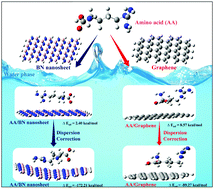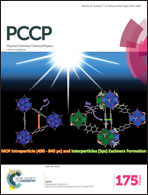Theoretical study of adsorption of amino acids on graphene and BN sheet in gas and aqueous phase with empirical DFT dispersion correction†
Abstract
Understanding interactions of biomolecules with nanomaterials at the molecular level is crucial to design new materials for practical use. In the present study, adsorption of three distinct types of amino acids, namely, valine, arginine and aspartic acid, over the surface of structurally analogous but chemically different graphene and BN nanosheets has been explored within the formalism of DFT. The explicit dispersion correction incorporated in the computational methodology improves the accuracy of the results by accounting for long range van der Waals interactions and is essential for agreement with experimental values. The real biological environment has been mimicked by re-optimizing all the model structures in an aqueous medium. The study provides ample evidence in terms of adsorption energy, solvation energy, separation distance and charge analysis to conclude that both the nano-surfaces adsorb the amino acids with release of energy and there are no bonded interactions between the two. The polarity of the BN nanosheet provides it an edge over the graphene surface to have more affinity towards amino acids.


 Please wait while we load your content...
Please wait while we load your content...